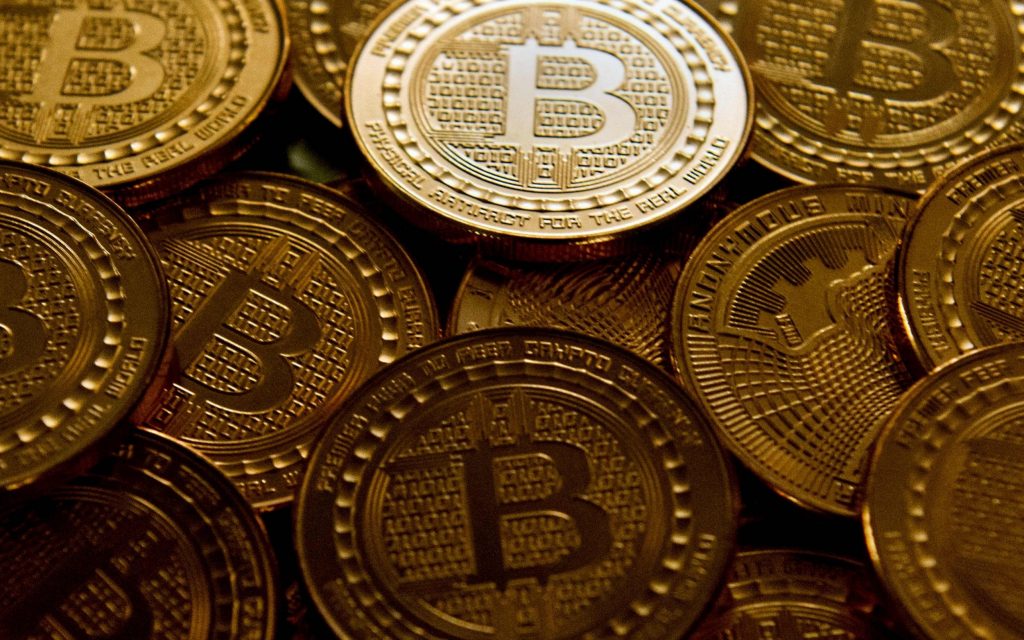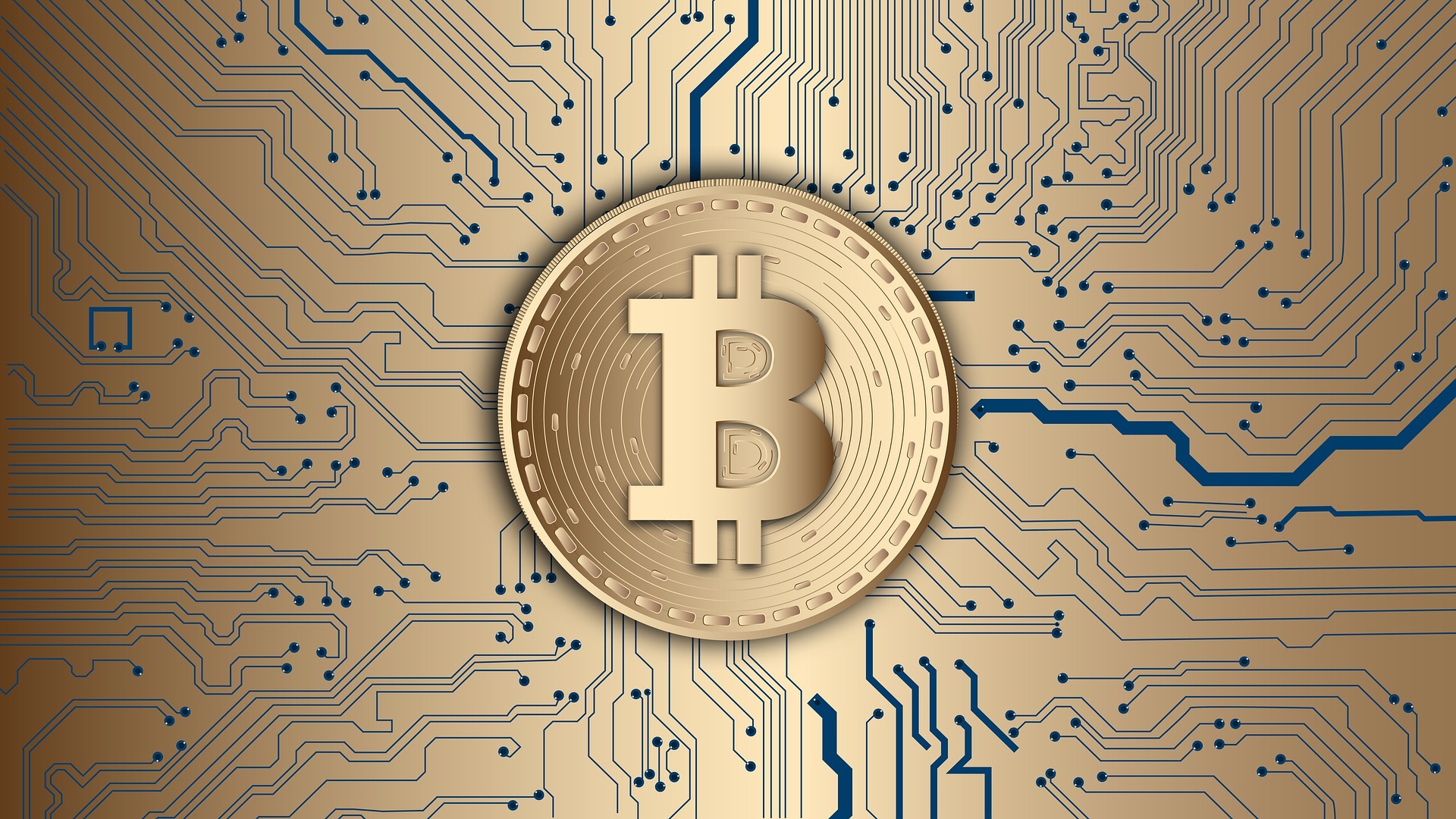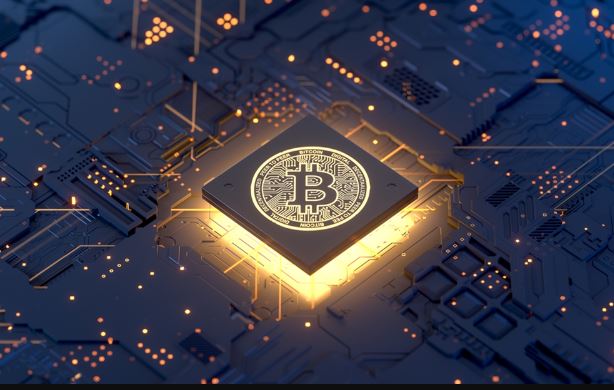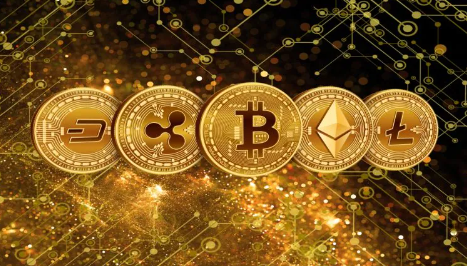Table of Contents
As Bitcoin and cryptocurrencies as a whole continue to gain mainstream awareness, more and more people are looking to become more knowledgable of the process with which new Bitcoin is created, a process known as mining. While your mind may jump to images of prospectors in the old West hoping to strike it rich, the reality is a little less glamorous. Pickaxes and dynamite have been replaced by ASICs and hash rates. While the world of Bitcoin mining can be complicated with its jargon and technical terms, we’ll go over the basics involved in Bitcoin mining as well as some of the more abstract terminology. However, before we discuss those, we’ll first go over the basics of Bitcoin mining, whether it’s still worth it to mine Bitcoin, and if it’s still possible to mine Bitcoin on your PC.

What is Bitcoin mining?
With traditional purchases, transactions are recorded on receipts, by banks and point of sale systems. On the Bitcoin network, the premise is the same but the method of recording the transaction is entirely different. Instead of receipts, a bunch of transactions are grouped together in “blocks” forming the blockchain.
These blocks function in much the same way as traditional ledgers but with Bitcoin, it’s a completely public ledger, and every user has complete access to this public ledger. When Bitcoin transactions are initiated, all of the devices (also referred to as nodes) on the network begin the process of solving the problem, with the first to finish claiming the reward.
When Bitcoin miners add new blocks to the blockchain, part of their job is to ensure that these transactions are legitimate by making sure that Bitcoin isn’t being copied by a process known as “double-spending.” Essentially, it’s similar to counterfeiting with traditional money, but a bit more complicated. If you were to counterfeit paper money, once you’ve spent it it’s gone.
With cryptocurrencies, it’s a little different. Since Bitcoin and other cryptocurrencies exist solely in a digital form, there’s the risk that the spender is cloning their Bitcoin and spending that while still holding onto the original. With counterfeit money, all you need to do is look at the serial number to see it’s a copy. With cryptocurrencies, for someone to do this, they would need to control 51% of all the mining power on the network. Fortunately, as the Bitcoin network grows, this becomes increasingly difficult as the cost to perform such an action would make it an almost impossible undertaking.
How does Bitcoin mining work?
Before you can actually start earning Bitcoin rewards, there are a couple of things that need to be completed. Firstly, you need to verify one megabyte (MB) worth of transactions. In theory, this can be done with just one transaction. In reality, it’s far more likely to be several thousand transactions.
Secondly, to be able to complete transactions and add blocks to the blockchain, miners need to first solve a complicated mathematical problem, also referred to as “proof of work.” To put it simply, what miners do is attempt to come up with a 64-digit hexadecimal number called a “hash” that is less than or equal to the targeted hash.
So, the mining machines come up with hashes typically measured in megahashes per second (MH/s), gigahashes per second (GH/s), or terahashes per second (TH/s) depending on the power of your unit. The machines will keep guessing the hash until they eventually find a solution.
At the time of writing, the difficulty level of the most recent block is over 14 million. This means that the chance of a node producing a hash that is less than the target is one in 14 million, which is pretty unlikely. This is why mining machines pump out hashes as fast as possible. However, this process is heavily reliant on electricity.
How long does it take to mine 1 Bitcoin?
In order to keep the difficulty level constant, it’s adjusted every 2016 blocks or about every two weeks. This ensures a new Bitcoin is created at roughly the same time. As Andreas Antonopoulos explains in his book Mastering Bitcoin: Unlocking Digital Currencies, each new block on the blockchain is generated every 10 minutes on the Bitcoin network. This governs the frequency with what is coin bit issued. As each block is completed, Bitcoin is issued to the node that completes it. However, over time, more miners join the network increasing the computing power and reducing the time it takes to create a new block.
Thus, in order to keep each block generating every 10 minutes, the difficulty of the coin bit mining must be adjusted. Antonopoulos goes on to explain that the difficulty is constantly adjusted to ensure each new block takes 10 minutes to create. This process occurs automatically and independently.
If the overall mining power were to reduce, the difficulty would increase and need to be adjusted, and vice versa if mining power increased. The rate at which new Bitcoin is created is similar to the rate at which commodities like gold are extracted from the ground – hence why this the process of creating new Bitcoin is called ‘mining’.
Today, in order to make Bitcoin mining profitable, specialized equipment called application-specific integrated circuit (ASIC) miners are used. There are several different Bitcoin miners available, but the most popular ones are the Antminer series from Bitmain.
In addition to the cost of the mining hardware, there will also be electricity costs as a result of the power needed by the machines as well, and any cooling equipment you may find necessary depending on climate. It’s for these reasons that professional miners are located in regions of the world with low electricity costs and fair weather, like China.
Bitcoin halving
Bitcoin mining is directly affected by a process known as halving. On the Bitcoin network, Bitcoin undergoes a halving event every 210 000 blocks mined or roughly every four years. These events cut in half the number of Bitcoins that are awarded to miners for their efforts and thereby halves Bitcoin’s inflation rate and the rate at which new Bitcoin enters the market. This will continue roughly every 210 000 blocks until the last Bitcoin has been mined and released into circulation.
With 21 million Bitcoin in existence and 18,391,612.5 already in circulation at the time of writing. This is expected to happen sometime in the year 2140. At that time, miners will be rewarded with fees users pay to transact. Though this doesn’t necessarily have to be the case. Theoretically, someone could develop a cryptocurrency to churn out as many units (or coins) as they wanted.
However, as is the case with Bitcoin, having a finite amount increases its value over time and ensures stability in the long term. Thus, as each individual Bitcoin is mined, the next one becomes slightly harder to create.
Bitcoin underwent its first-ever halving in November 2012. The event was hotly anticipated by traders as parties were held all around the world. Once the 210,000th block was completed, the mining rewards dropped from 50 to 25 Bitcoin. To celebrate the milestone, early adopters all over the world threw halving parties. At the time of the halving, Bitcoin went from trading at around $11 to almost $1,150. Since then, halving events always correlate with intense boom and bust cycles, generally ending with the price higher than before the halving.
At the time of the second halving in July 2016, when rewards dropped from 25 to 12.5 Bitcoins, the cryptocurrency was trading at around $650. Again, Bitcoin underwent a period of heightened volatility and by the end of the following year, it crossed its highest ever price of $20,000.
The price then began to fall over the course of the year until it hit $3,200 – while that may seem like a significant drop from its all-time high, it was still almost 400% higher than its pre-halving price. With the third halving event having taken place on May 11, 2020, the number of Bitcoins rewarded to miners has dropped from 12.5 Bitcoins per block to 6.25 per block, worth around $57,500 at the time of writing.
Is mining Bitcoin worth it?
While Bitcoin mining, in theory, is still available for anyone to do, you’re going to need specialized, high-powered machinery to make any kind of money through mining. Therefore, the short answer is likely “probably not.” While the early days of Bitcoin mining are often likened to a gold rush, today, the remaining Bitcoin is stuck under the cryptographic equivalent of a mountain of rock.
Thus as a smaller player, mining Bitcoin is going to be unprofitable. The Bitcoin mining industry is dominated by large businesses, and the required equipment will eat into your profits. Furthermore, the electricity costs involved will likely cost more than you’ll make from mining. It’s also important to note that However, despite the difficulty, it isn’t impossible for one to make a profit from transactions.
If you’ve decided to pursue Bitcoin mining, you’re going to need to choose your mining hardware. This is an important decision considering the complexity and cost involved in Bitcoin mining. There are also several important aspects you will need to consider.
Problems facing home miners
You’ll also need to be aware of the issues that home miners can be faced with. Things like hardware failures, power outages, crashes in Bitcoin’s price, and network disconnections. All these factors can make it impossible to recoup the cost of the machinery and electricity. As such, making any money by mining on your own is extremely unlikely.
While this may the case today, it doesn’t necessarily mean Bitcoin transactions will stay like this. Advances in mining hardware technology while cheap and reliable forms of electricity generation are taking hold. This might make Bitcoin mining profitable for the individual miner again while simultaneously improving the quality of the network. But for the time being, joining a mining pool might be a better alternative.
Pooled mining
Given the level of competition involved in Bitcoin mining today, many new miners opt to join a mining pool instead of going at it alone. Pooled mining is a different approach where multiple users contribute their computing power to generating a new block.
A pool of miners has a much greater chance of solving a block and reaping the rewards given the much larger number of miners involved. However, because members of the pool all contribute resources, most pools will split the rewards for the block between all the miners according to the amount of power contributed. Therefore, joining a pool can provide a steady income stream despite the payouts being more moderate compared to a full block reward.
There are different methods mining pools can use for the distribution of block rewards. The pay-per-share approach, for instance, offers instant and guaranteed payouts for the miner’s power contribution. Miners in the network are paid from the pool’s existing balance and can withdraw their payout immediately. This model ensures the most consistent payout for miners while most of the risk from transactions is taken by the pool’s operator.
Poolin and Slush Pool
In the proportional method, miners earn shares until the pool finds a block. At this stage, each user gets an equal reward with the cost being calculated at the end. There are many other methods that mining pools can use to operate and issue rewards, like the Geometric Method, Double Geometric Method, and Bitcoin Pooled mining (BPM).
If you’re interested in joining a mining pool, the process is relatively straightforward. You’ll first need to decide on which pool to join. The good news is that you’re free to switch between different pools whenever you like. So if you pick one and don’t like it, don’t stress. There are several good ones available, with Poolin, F2Pool, and BTC.com being the three largest. However, Poolin and Slush Pool are two of the most popular network.
Once you’ve decided, you’ll need to sign up and create an account on the pool’s website. Once your account has been set up, you’ll need to create a ‘worker’. If you have several pieces of hardware, it’s possible to create several workers and assign them to each piece of hardware. There are a couple of important things to note here, however. The first is that in order for Bitcoin miners to be eligible to earn rewards, the miner first has to verify one megabyte worth of transactions. It’s possible to do this with just one transaction, but it’s far more likely that it will take several thousand transactions on the block.
Can I mine Bitcoins on my PC?
Back when Bitcoin first emerged to the public in early 2009, a lot of people were drawn to its revolutionary nature. The idea of becoming a part of a new form of money, one that operated independently from banks and governments, where its users were the ones in charge of approving transactions came as a breath of fresh air, especially among those who shared Satoshi Nakamoto’s frustration at institutionalized banking.
At this time, Bitcoin was also worth almost nothing, so the motivation behind mining was more than just profit. But, as it began to grow, people started experimenting with different ways of mining.
Eventually, someone discovered that using high-end graphics cards made the process was significantly more efficient. It didn’t take long for dedicated mining machines to emerge. These devices further improved the mining efficiency by as much as five times, paving the way for a fully-fledged Bitcoin mining industry.
Miners own equipment
In those early days of Bitcoin, it was possible to mine a block with your PC at home. If you had a decent enough graphics card or even an old laptop, it was possible to make a profit from the process. There are several reasons for this. Firstly, miners already owned the equipment so mining Bitcoin presented no upfront costs.
Secondly, this was before the days of professional mining sectors, so miners only had to compete with other individual miners on home computer systems. Finally, it’s because of the Proof of Work process utilized by the Bitcoin blockchain. This proof of work algorithm is used to complete the transactions and create every block, but miners must compete against one another to do so. Proof of Stake is an alternative to Proof of Work.
FPGAs more power-efficient than GPU
Then, as mining became more popular, Bitcoin miners began experimenting with other technology starting off with graphics processing units (GPUs) and computer processing units (CPUs) found inside home computers. As mining became more difficult, miners turned to field-programmable gate arrays (FPGAs) which are more power-efficient than GPUs.
Finally, and the technology most miners use today, is the integrated circuit (ASIC) system. The costs and effort involved in Bitcoin mining have made it a decision that can have both long-term and short-term consequences. These systems can range from several hundred dollars up to about $10,000. So, to make every long story short, it simply isn’t worth the effort to mine Bitcoin on your computer anymore.
Cloud Mining
If you’re looking to invest some time into Bitcoin mining, cloud mining might be better suited as you don’t have to worry about purchasing and managing your own mining hardware. Instead, you purchase mining contracts that allow users to rent server space to mine coins through the use of shared processing power run from remote data centers. This takes a lot of the hassle out of mining as you don’t have to worry about hardware, software, electricity consumption, or every issue facing individual miners. All you need is your computer and a Bitcoin wallet to complete your transactions.
With that being said, there are still risks involved in cloud mining that investors need to be aware of before making any decisions. There has been a huge amount of mining contract scams. Some firms will offer “lifetime contracts” that can be appealing as the costs stay the same and supposedly offer excellent returns from transactions. However, as every difficulty of mining increases, this investment will offer diminishing returns.
Further, some companies will highlight the potential for excellent returns from transactions while being less transparent about the true nature of the costs or the network involved. Others are simply Ponzi schemes, so it’s vital to conduct every research before making any investment decisions.
Another factor to consider is that you’re handing overall control to the cloud mining operators. This might result in the firm ceasing every operation if it deems Bitcoin’s value too unstable. Finally, you’ll also need to keep in mind that the profit from transactions is likely to be far less as you’ll be paying the operators a commission to cover their costs.
Is Bitcoin mining sustainable?
The Bitcoin network, being relatively new compared to the developed infrastructure of traditional finance, isn’t quite as efficient. Currently, the Bitcoin network can process about seven transactions per second, with the transactions being logged every 10 minutes. By comparison, Visa can process about 24,000 transactions per second.
However, with the Bitcoin network continuously developing, eventually, the number of transactions made every 10 minutes will exceed the number of transactions that can be processed in 10 minutes. It’s at this point where waiting times increase and will continue to get longer unless changes are made to the Bitcoin’s protocol.
Off-chain layer vs Segwit Witness
This sums up “scaling.” Generally, Bitcoin miners agree that something needs to be done, but as for how to go about it, there is little consensus. However, there have been two major suggestions put forward. The first suggestion is to create a secondary “off-chain” layer to Bitcoin’s network so some of the transactions can migrate off of the main blockchain. The other suggestion is to increase the number of transactions that can be stored in each block.
Then, in July 2017, miners and large mining companies, representing around 90% of the network’s power opted for the first solution when they voted to integrate a program that would decrease the amount of data required to verify each new block. This program is called Segregated Witness (SegWit). Segregated means separated and Witness refers to the transaction signature.
Thus, SegWit means to separate transaction signatures, thereby removing parts of the transaction and freeing up space. This has proven quite effective as signature data is estimated to account for as much as 65% of the data processed in each transaction.
However, not everyone agreed with the decision and, one month later, a group of developers and miners decided to leave Bitcoin’s network through a hard fork, creating a new cryptocurrency built using the same codebase as Bitcoin. Opting for the second option, they argued that implementing SegWit was not a permanent solution to the problem. The result of their endeavors was the creation of Bitcoin Cash which includes block sizes of 8 MB as opposed to Bitcoin’s one MB block size.
Bottomline
While Bitcoin mining can be a complicated and convoluted subject, hopefully, this guide has helped clear up a few sources of confusion. So, if you were thinking of getting into Bitcoin mining, doing so from your PC isn’t recommended. However, if you’ve got the cash for mining hardware, consider joining a pool or simply go at it alone if you feel you’re up to. Otherwise, there’s always cloud mining. Whatever your decision, we wish you the best of luck in confirming those transactions!
- Michaël van de Poppe: Bitcoin to Hit $500,000 This Cycle? 🚀💸 Or Just Another Crypto Fairy Tale? - December 21, 2024
- What is the Meme Coin Bonk, Price Predictions 2025–2030, and Why Invest in BONK? - December 18, 2024
- BNB Price Analysis: 17/12/2024 – To the Moon or Stuck on a Layover? - December 17, 2024
























